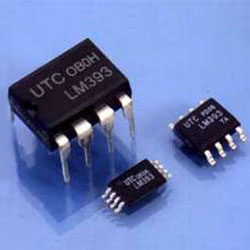
Massively Integrated SoCs
Moving way up the integration ladder from op amps and amplifiers to what is described today as massively integrated system-on-chip (SoC).
These application-specific mixed signal ICs (combining analog and digital circuits) reveal some interesting new products that promise to up the audio quality on information appliances and lower the demand for a real audio engineer.
The latest in massive-scale integration leaves less and less for the audio engineer to do. Most—if not all—of the actual analog audio portion of the design is moving deeper into the silicon layer.
Already most information appliances consist of only three or four chips.
The next generation will have just one chip. One chip that does the microprocessing, mass storage memory, all the DSP functions, power supply management, and all audio input and playback path functions.
To this chip are connected the internet (hardwired or wireless), keypad, display, microphone, and loudspeaker or headphones.
There is not much left for the audio engineer—which makes much of this paper irrelevant, and clarifies the last sentence of the opening section: “If you have audio circuits to design…”
Here is just a tiny sample of powerful single chips available today:
From Cirrus Logic/Crystal Semiconductor comes the CL-PS7500FE System-on-chip with CRT/LCD Controller, combined with their CS4333 Codec and CS8900A Ethernet Controller creating a powerful Internet information appliance.
It directly accepts audio inputs and directly drives audio outputs.
While not a true one-chip solution it leads the way.
Impressive is Texas Instruments’ TMS320DA250, claimed to be the industry’s most highly integrated single-chip DSP+codec solution for portable digital audio systems.
Based on TI’s very successful low-power TMS320C5 DSP core found on many information appliances already (e.g., Sony’s Network Walkman , JVC’s e-CyberCam, and Digital 5’s Internet Jukebox platform), the DA250, as it is called, considerably ups the ante.
Once everything is on one chip, all that’s left is to eliminate the D/A converters and use the digital audio bit stream to directly drive the power amplifiers.
All Digital Audio Power Amplifiers
The next big thing in integrated audio power amplifiers is digital input. Traditional Class D power amplifiers have analog inputs.
The analog signal is converter into pulse width modulation (PWM) which drives an H-bridge (so called because the loudspeaker is connected bridge-style between two complementary MOSFET pairs, the whole thing forming the letter-H).
Normal digital data is called pulse code modulation (PCM).
With PCM each sample is represented by a word made up of ones and zeros, as the value changes from sample to sample the number of ones and zeros change. With PWM, the width of the pulse changes from sample to sample.
Successfully changing PCM into PWM has been a long quest, and is the technique behind digital input power amplifiers, which some people used to call “power DACS,” since that is just what they do—convert digital data into analog power output. (Techniques other than strict PWM exist, but for clarity purposes all approaches are generalized here as PCM-PWM.)
